
All of my life, I've heard people say bad things about cats. Both my sister and my cousin are afraid of cats because our cat as a child was aggressive with them (but he was gentle with me). Garfield makes cats look aloof, selfish, gluttonous, lazy and somewhat evil. Bill the Cat made them look stupid, dirty, addicted and lazy. Sylvester the Cat and Tom Cat made cats look lazy, scheming and untrustworthy, and somewhat dumb in the former's case. Healthcliff made them look easy to anger playboys who were untrustworthy but were clever and not entirely bad (despite stealing, lying and cheating). Tigger (actually, a tiger, but still a feline) made them look friendly, energetic and fun, but dumb and unreliable (probably ADHD, these days). The Cheshire Cat made them look, well, bizarre, although possibly in a good way. Before you say "Hello Kitty" - I have to ask what's up with that non-feline nose and why doesn't it have a mouth? ;) And why are there so many claims out there that Sanrio said it's not a cat although their product description says it's a cat? It seems that cats are, in general, portrayed as being aloof, anti-social, untrustworthy, sneaky and clever at some things.
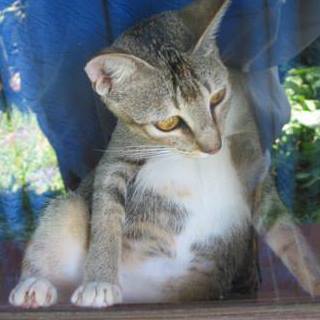
The first in a long line of wonderful cats, Suci (soo-chi) disappeared while being cared for during our honeymoon. We don't know if the person watching her was careless, killed her, she escaped, got poisoned or stolen. :( I learned from this cat what I'd already know from my childhood cat and years of being around cats - that cats are not easily stereotyped and can behave in ways that cat-haters don't expect. Both cats and dogs have hierarchies but, in the wild, cats don't band together in groups, whereas dogs do (which poses a threat to both wildlife and humans, unlike cats). However, cats CAN be social, especially if they are taught to do so in a loving home. Cats and dogs both come in a wide variety of breeds as well as behaviors but both can, surprisingly, be molded to behave in specific ways. This is the point of my post.
I've heard about evil people who do evil things to cats (and dogs, and other animals), and that is wrong. I'm not going to talk about those people, though. This message is for people who want to choose and raise loving, social cats. It's even for cat-haters who are willing to learn. I have come to believe that cats are generally not so social out of necessity (competition for food as well as a long history of having no guidance on how to behave otherwise) rather than instinctually. I have seen that how you choose a cat and raise it has a major impact on its behavior.
Over the years of having cats, from 2002-2017, we had numerous cats and their behavior was predictable, based on those two factors only. If we chose according to the info below, we were guaranteed a good start and an excellent chance of having an amazing cat in our lives. If not, well, the stereotypical cat was much more likely (but not unavoidable).
If we raised it as I'll explain in a moment, without choosing correctly, we MIGHT get a good cat, depending on its behavior when we got it. If we did both, we were always guaranteed an exceptional cat! In just two steps (and yes, you need patience), you're setting yourself up for an amazing cat! And, yes, we did try avoiding all or part of one or both steps, with predictably mediocre (at best) results...Hopefully, the information here will help YOU to have wonderful cats, too!
STEP 1: How To Choose Your Cat
Choosing your cat is not hard as long as you're willing to be patient, especially if you want a particular breed or color pattern. I can't explain differences in breed personalities because I never worried about something as unimportant as breed. I just wanted wonderful cats. I've done this with many cats, so I know it works. I've had cats that would follow us on walks to the edges of their territory, cats that would play fetch, and cats that play and warn gently, and are patient with tail-pulling ankle-biters (kids).
The first step is to be where cats are (e.g. a farmer's market, a fish market, or an animal shelter), and wait. If you're at an animal shelter, don't be there right before feeding time as they're liable to behave atypically, or right after feeding time as they're liable to ignore you. Call ahead and ask. If you're in a public place, a cat that will approach you because you've got food MAY be a candidate, but it's no guarantee. The idea is to get a cat because it wants you, otherwise you'll have to play the long game of feeding it every day for weeks or months, and that still won't guarantee the family cat I'm offering you.
The orange one is showing its flank to try to intimidate the other one. A cat that does this to you is telling you you're in for a fight.
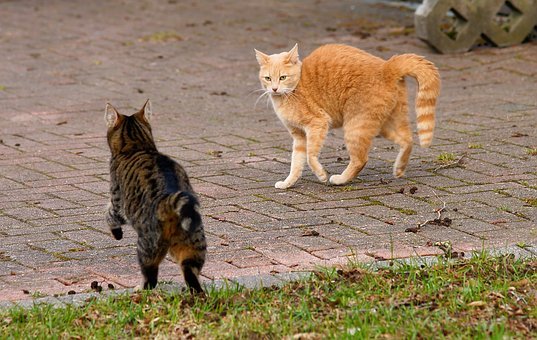
You don't want to befriend a cat that was just in a fight. It's upset and isn't in the mood for overtures.
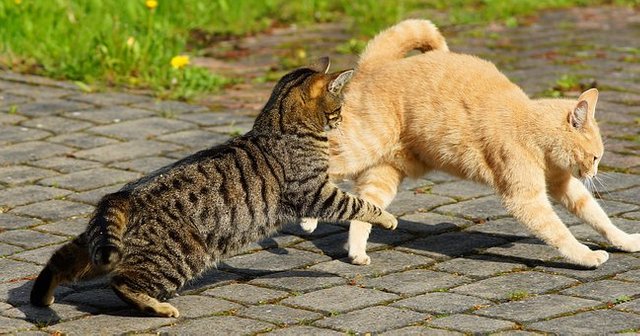
This one is startled and will probably flee unless it feels safe:
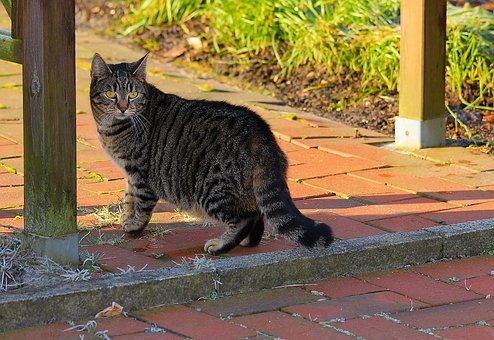
If you see a cat that seems wary of you or unhappy with your attention, forget it.

If you see a cat eating, (or a lion!), it's best to stay away. A stray cat will be liable to pick up its food and walk (or run) away, and a lion will be liable to defend its kill. You don't want to end up on the menu, right?

And this means: "Back off!" (Yes, I know it's a cheetah. Wild species are not good pets!) The posture may be lowered head or raised up, and the back will probably be up and fur standing, with the teeth bared, eyes open, and face distorted.

If it spits, hisses and assumes a threatening posture, you're wasting your time. At best, it will bond with one person and behave vilely with everyone else. At worst, it'll hide all the time, attack people and/or behave aggressively/fearfully when approached. It takes an extraordinary amount of time, attention and love to get such a cat to trust a person.
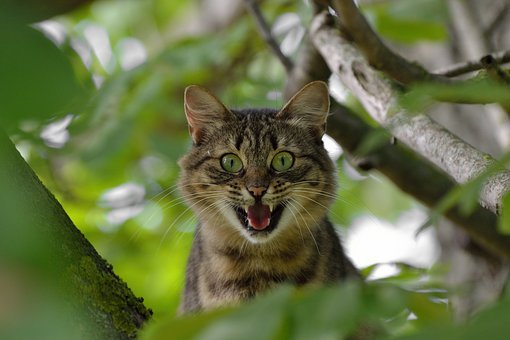
You're screwed: XD

This one, keep your eyes on it, be ready to run or fight, and leave the scene as soon as possible because it's probably going to suck up your soul. ;)

Taking on sick cats, friendly or not, should be left to those with experience in treating cats. It can also be a heartbreaker and/or an unpleasant experience.
https://encrypted-tbn0.gstatic.com/images?q=tbn:ANd9GcSmngR3nFWYZh2aC5cMc-5q6k8EAf4WFD_ZkHXFjR0iUHA3U0NBPw
This cat is busy playing or hunting and may not want to be bothered, or it may play aggressively. Wait until it's calmed down.

A cat that seems curious, like this one, may or may not be approachable. Walk slowly and if it starts moving away, give up.
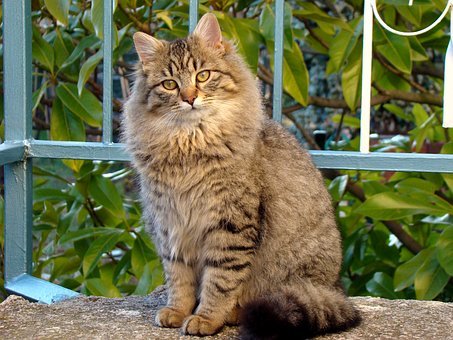
This is a yawn.
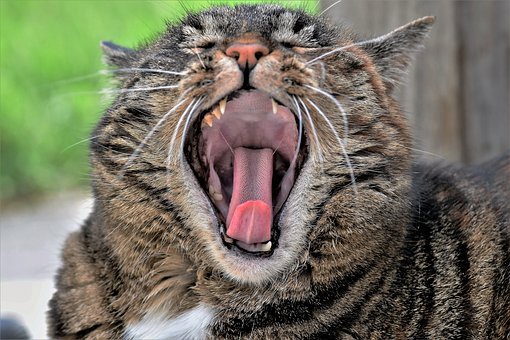
This one's playful and may scratch, nip or even bite. Showing its belly can be a sign of submission (as with dogs) or trust. (If you've been playing rough with your cat, and it then turns on its back and has its paws ready and mouth open, it's saying "I'm going to start getting rougher now.") Let it be if in doubt.
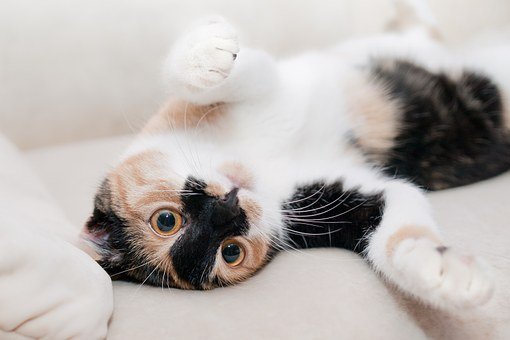
Cats that are grooming each other are more likely to be approachable - but that doesn't mean they're interested in you.
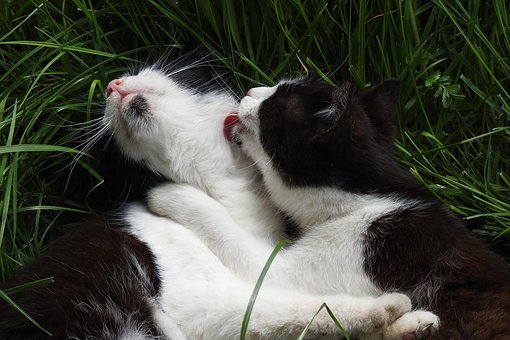
Your best bet is a young kitten because they are less likely to have been traumatized by cat-haters and evil people, and less likely to have already bonded.
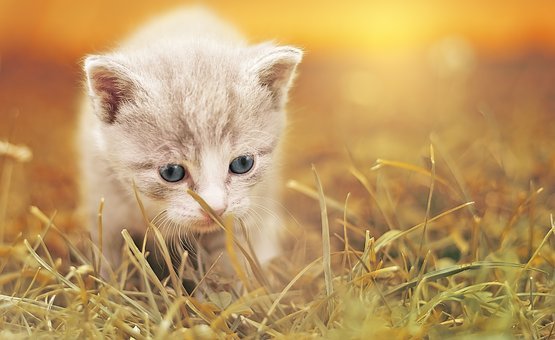
A cat that doesn't run away as you approach it is a positive sign.
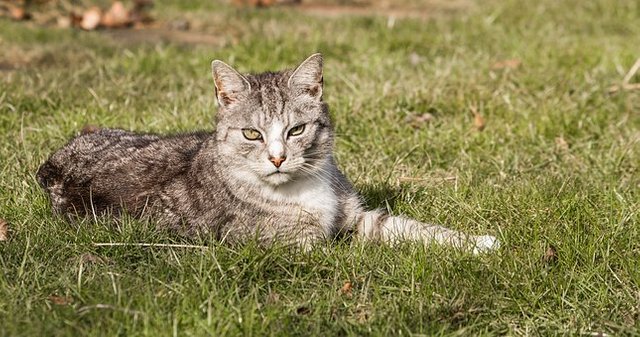
If it'll let you pet it, especially without food being involved, that's a great sign.
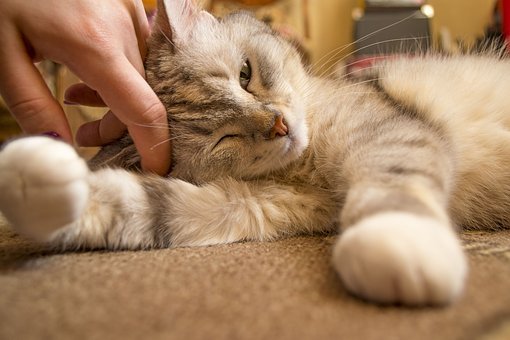
Ideally, you want this: a young, healthy kitten that is approaching you and rubbing against you.
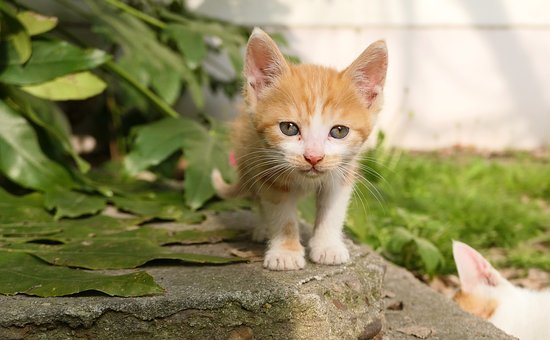
Keep in mind that the eye color of some very young cats will change...
Again, you want a young kitten that is healthy, and it should be coming up to you, mewing and, better yet, rubbing against you. If it's still got its eyes closed, it probably hasn't been weaned off its mama's milk, so you're going to have to be able to feed it with a bottle...often, which is not the ideal choice for many people. You shouldn't be proffering food to entice it to come to you and you should never choose based on specie or appearance, unless you have the patience to wait for exactly the cat with the physical attributes you want, plus what I'm telling you now.
STEP 2: How To Raise Your Kitten To Be an Amazing Cat
Mission half-accomplished - you've got your ready, willing and friendly kitten! Now, you need to bond with it. If there are others in your home, everyone should - especially if they want to have a good relationship with it.
Some people may ask: Could I pick up an older cat that is friendly? Yes, you could, and it may be a nice cat (especially if it's someone else's house cat) but, if it's old enough, you'll probably never be able to form a strong bond with it and, thus, get the desired behavior (kinda like this, without the imminent threat of your kids being eaten). ;)

Everyone should hold the cat whenever it's willing, every day and, best choice, put it between your legs while you sit open-legged. This is because cats are scent-oriented, just like dogs, and the strong smell of your crotch and butt help the bonding process. The love and smells help the kitten to understand who its family is. Pet its body nicely, and scratch gently all around its head - even inside the ears (carefully, though!). The nicer you all are to it, the nicer it will be to everyone - including guests.
If a family member is rough with it, it'll be rough with that family member, too, and that roughness may spill over to other people. Rough playing with a small kitten teaches that kitten that it's appropriate, and it'll continue to play roughly throughout its life. Gentle playing, likewise, results in a cat that will play much more carefully.
If you want to play in a different way, I suggest the old "bright pinpoint of light" trick, which'll get your loving cat really excited and active without it believing that it's okay to be rough with you. Something that it won't associate with you allows you a bit more latitude than direct playtime.
ALERT:
One of the less pleasant parts of bonding originates from the action of getting the mama cat to give milk. Kittens will knead you with their paws especially when feeling relaxed and safe. Unfortunately, their claws will be out a bit so, if you don't want to be accidentally clawed by a loving kitten reflexively kneading your leg (or elsewhere!), wear clothes that are thick enough to prevent damage or put a towel or blanket in place. I don't think a hungry kitten will latch onto an exposed nipple, but I wouldn't recommend tempting fate!
The loving treatment of the cat should continue into its adulthood. The longer you're nicer to it, the longer it's going to be nice to you. A cat treated with gentle love will be one that plays gently, is patient with babies who pull on its tail and otherwise bother it, and will give safe warnings of displeasure, such as a gentle nip and body language (you'll have to pay attention, but things like turning on its belly while playing, ears back and/or a change in the facial expression and quick twitches of its tail signal irritation), which you can learn and act on so that you don't push things too far.
The first 2 years of its life are the most critical for defining its behavior. Of course, as a cat gets older, especially when it is pregnant, there may be some changes but, again, long-term affection makes a big difference.
Remember that cat intelligence varies and some will be smart enough to open cabinets and doors, flush toilets, dispose (i.e. play with and shred) of an entire roll of toilet paper, and other things you don't expect. Cats can also be taught to jump very, very high, play nicely (and even be loving) with other kinds of animals. Provide an environment that is multi-tiered for its exercise, physical & mental health, and entertainment.
Tips:
-Give your cat love every day.
-Get your cat (and many other animals, too) vaccinated against toxoplasmosis. If your wife is having trouble with miscarriages, have her checked for it.
-Spay/neuter it if you're against having kittens from it.
-If you live in an area with endangered small animals, keep your cat indoors/away from them.
-Get other vaccinations that have a proven track record and are non-adjuvant. http://catinfo.org/vaccines-for-cats-we-need-to-stop-overvaccinating/
-Offer your cat a variety of foods and even try your hand at making your own. There are lots of recipes out there!
-Learn what things kill cats: Human Foods that are Dangerous for Cats
-Provide your cat with a scratching post, climbing areas and toys so that your home is stimulating. Stimulation prevents boredom and helps keep your cat physically fit.
-Put a collar with a tag on your cat.
-Spray your cat with a spray bottle when it does something naughty. Cats also dislike aluminum foil and double-sided sticky tape, both of which can be used to discourage them going on forbidden places.
-Since your cat will jump up onto eating and cooking surfaces in the kitchen, always be sure to wipe it down with a disinfectant before use!
-Feed your cat the right amount and don't allow it to eat foods that will make it fat - especially processed foods!
-Make sure you use nice litter for its box and scoop out waste routinely (not like a friend of mine who'll go for weeks!).
-Periodically check for fungus, ticks, mites and fleas.
-Give it deworming medicine periodically.
-Bathe your cat infrequently. If you must, use warm water so it's pleasant for the cat. If you start this when it's young, it may be easier, but I found that firmly holding my cat down at the neck (no, not choking or crushing) made it docile.
4 bits of interesting feline trivia:
- A large number of cats in Indonesia either have crooked or very short tails (like Manx).
- Tri-color cats are almost always female. In Indonesia, they would be patchy patterns of black and medium brown/orange on white, with no sense of order or continuity from mother to kits.
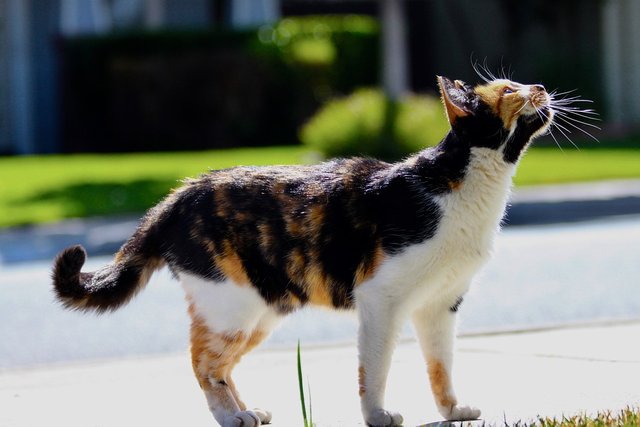
- Contrary to popular belief, cats are not purely carnivores. They will, without prompting or mixing, eat certain vegetables, bread, and tofu, for example. They don't really seem to care for rice, though!
- Finally, cats can be socialized to like other animals - even dogs.

The pictures are from Pixabay, except the Cheshire cat, which is no longer copyrighted, and my cat, Suci, which is my photo. :)!
If you appreciate this article, please upvote/like , resteem/share
, resteem/share and share it to Facebook
and share it to Facebook , Twitter
, Twitter , Reddit
, Reddit , LinkedIn
, LinkedIn and wherever else
and wherever else you can!
you can!
I've always been a fan of cats.... I love their intelligence
Downvoting a post can decrease pending rewards and make it less visible. Common reasons:
Submit
It is pretty remarkable how smart some of them are, isn't it? What did you think of my article?
Downvoting a post can decrease pending rewards and make it less visible. Common reasons:
Submit
@resteemator is a new bot casting votes for its followers. Follow @resteemator and vote this comment to increase your chance to be voted in the future!
Downvoting a post can decrease pending rewards and make it less visible. Common reasons:
Submit